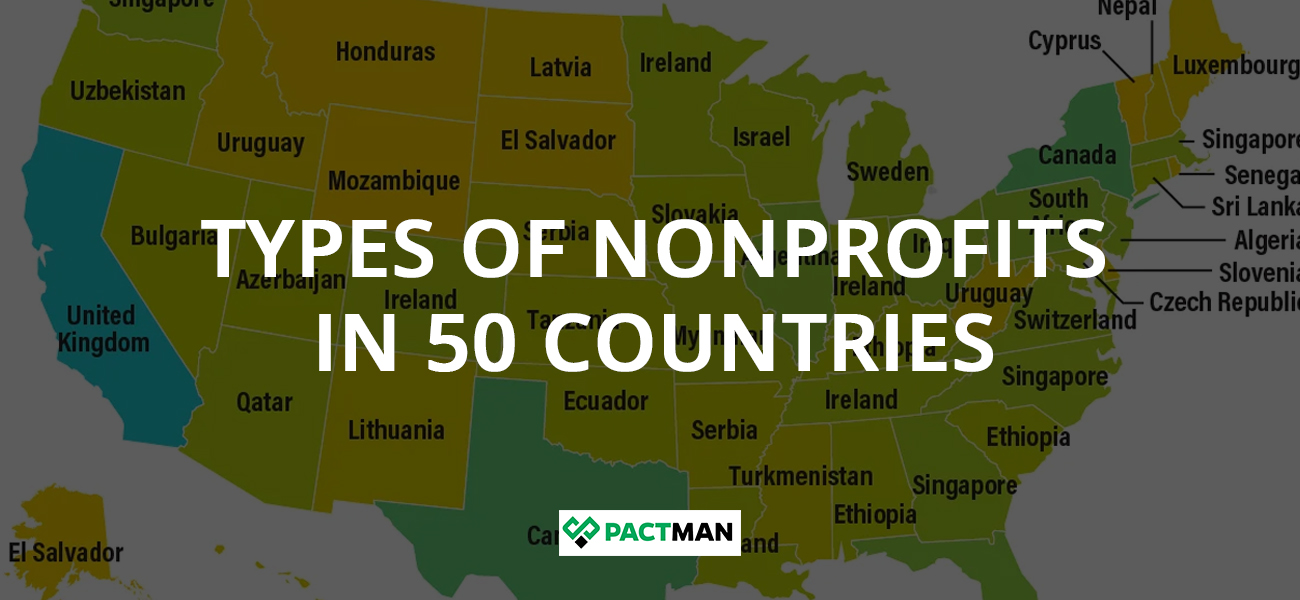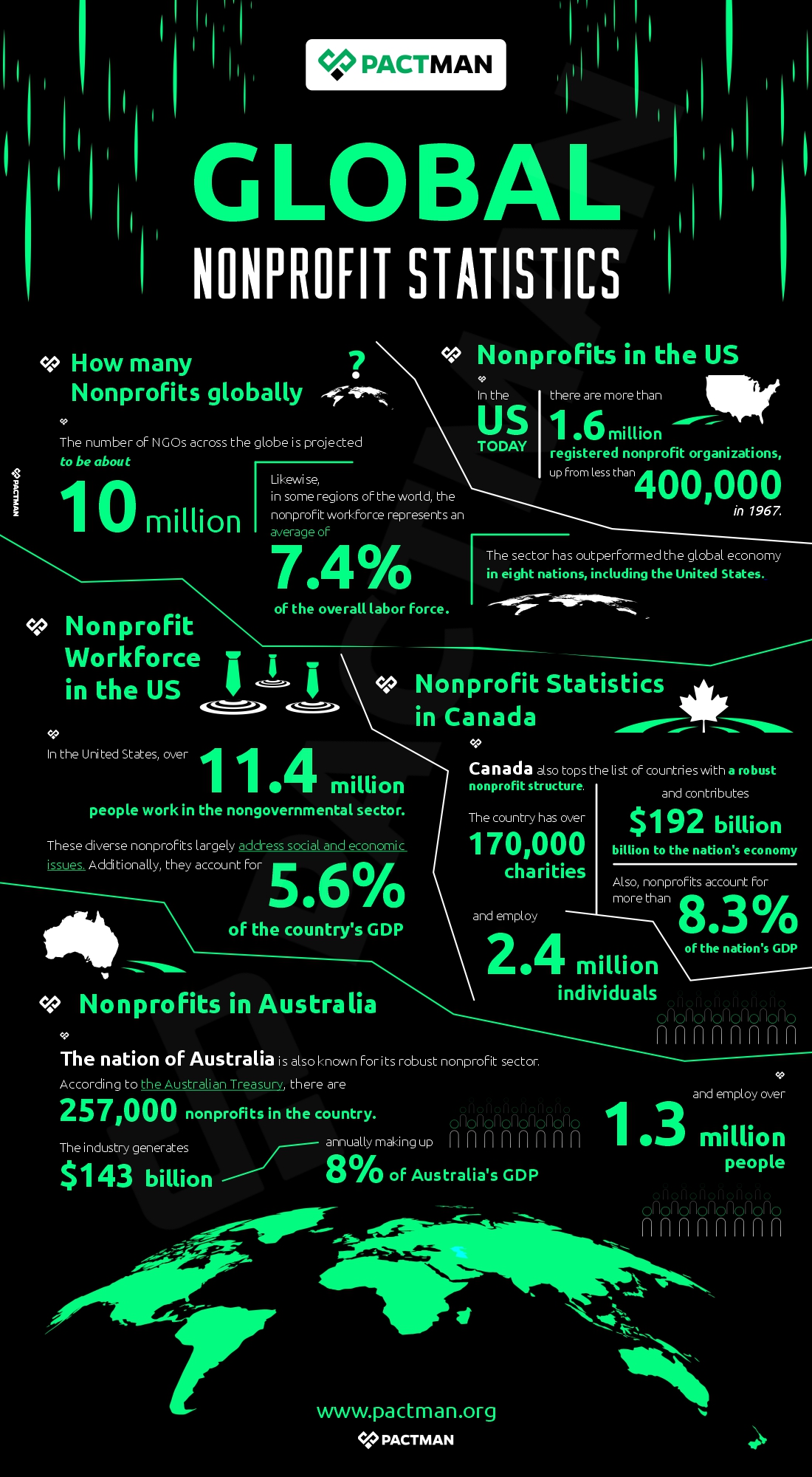Comparative research is becoming more popular as a result of the increase in the various types of nonprofits globally. Generally speaking, significant nonprofit reforms have mostly taken place in the last few decades.
This article seeks to compare the activities and similarities of nonprofits spread across 50 countries. Likewise, we will consider the types, activities, and development of the nonprofit sector globally.

- In recent decades, nearly all nations worldwide have recorded an exponential increase in the activity and influence of nonprofits.
- The number of NGOs across the globe is projected to be about 10 million.
- The various types of nonprofits globally are critical economic players and major contributors to the well-being of citizens.
What are the common types of nonprofits globally?
Several English-speaking nations appear to have similar laws governing the various types of nonprofits. Hence, we’ll consider the common nonprofit categories that exist in over 50 countries.
1. Companies Limited by Guarantee
Companies Limited by Guarantee constitute one of the most prevalent types of nonprofits. Principally, these entities are distinguished by a lack of shareholders.
Also, these organizations are governed by the Companies Act of each nation. Among such countries known to operate this system are the United Kingdom, Australia, Tanzania, Nigeria, and Saint Lucia, among others. A large portion of the Caribbean nations such as Saint Vincent and the Grenadines, Trinidad and Tobago, Micronesia, and Barbados also operate a Company Limited by Guarantee.
2. Charitable Trusts
Although these types of nonprofits exist in most nations, they are often coined in different forms. In the United Kingdom, Australia, New Zealand, Belize, Zambia, Kenya, Gambia, and Mauritius, they are referred to as Trusts or Charitable Trusts. However, in Saint Lucia and Saint Vincent and the Grenadines, the Act recognizes these nonprofits as International Trusts.
Generally, a charitable trust is created to hold and safeguard assets (money, property, etc.) for charity purposes. Hence, the trust’s assets are handled in accordance with the goals stated in the trust deed or a set of accepted guidelines.
3. Unincorporated Associations
An Unincorporated Association is established through an agreement between a group of people who get together for a purpose other than to make a profit. These types of nonprofits comprise voluntary groups and sports clubs, among others.
Some of the countries that practice this system of “nonprofitism” include the United Kingdom, Nigeria, Belize, New Zealand, and Liberia.
Also, a few of these countries have established Acts governing their registration and operation. However, an unincorporated association can operate without the need for registration.
4. Incorporated Associations
Incorporated Associations on the other hand are registered legal entities typically created for charity, cultural, or recreational purposes. These types of nonprofits are legally established in a state or territory with laws that govern their operations.
Countries such as Australia, New Zealand, Papua New Guinea, and Tonga operate this nonprofit system.
By and large, a legal entity can be created in a voluntary, easy, and affordable manner through incorporation. Likewise, an Incorporated Association serves as an alternative to establishing, say, a co-operative or a corporation limited by guarantee.
5. Foundations
A foundation is a nonprofit corporation or charitable trust that awards financial aid to institutions, groups, or people for causes like research, education, the arts, and religion. Also, some foundations take part in humanitarian initiatives and projects as well.
Some of the countries that operate these types of nonprofits include Canada, Uganda, the Bahamas, Belize, and Barbados.
Unlike public charities, which typically solicit donations from the general public to fund institutions or programs, foundations are subject to tougher rules.
6. Cooperative Societies
These types of nonprofits are established by a group of people who come together to advance the financial interests of their members.
In general, the idea of a cooperative society is not new. These entities are practically ubiquitous and prevalent across the globe. Cooperatives are active in every nation and industry, including food, finance, healthcare, and agriculture.
A large number of Caribbean nations such as Saint Lucia, Micronesia, Trinidad and Tobago, Guyana, and Tuvalu operate this class of nonprofits. Other African nations that run a cooperative system include Ghana, Liberia, Papua New Guinea, and Cameroon.
How many nonprofit organizations exist worldwide?
The number of NGOs across the globe is projected to be about 10 million. In some regions of the world, the nonprofit workforce represents an average of 7.4 percent of the overall labor force. The sector has outperformed the global economy in eight nations, including the United States.

In the US today, there are more than 1.6 million registered nonprofit organizations, up from less than 400,000 in 1967. By and large, nonprofits have multiplied, expanding in scope, size of staff, and financial resources.
What are the countries with the most developed nonprofit sector?
The various types of nonprofits across the globe are critical economic players and major contributors to the well-being of citizens. We will consider a few countries that are known for their vibrant nonprofit sector.
1. United States
In the United States, over 11.4 million people work in the nongovernmental sector. These diverse nonprofits largely address social and economic issues. Additionally, they account for 5.6% of the country’s GDP.
2. Canada
Canada also tops the list of countries with a robust nonprofit structure. The country has over 170,000 charities and contributes $192 billion to the nation’s economy. Also, nonprofits account for more than 8.3% of the nation’s GDP and employ 2.4 million individuals. By and large, the employment rate exceeds that of the mining, agriculture, oil and gas, retail, and transportation industries in the country.
3. Australia
The nation of Australia is also known for its robust nonprofit sector. According to the Australian Treasury, there are 257,000 nonprofits in the country. The industry generates $143 billion annually making up 8% of Australia’s GDP and employs over 1.3 million people.
4. United Kingdom
Closely followed by Australia is the United Kingdom. The UK Civil Society Almanac, NCVO reports that there are over 165,758 nonprofits. Overall, the sector contributes £20 billion to the country’s GDP.
5. New Zealand
New Zealand also stands out for its robust nonprofit sector. Altogether, there are over 114,000 NGOs that operate in the country. Hence, the sector also makes up one of the largest charity industries in the world with annual revenue of over $20 billion.
6. Singapore
To sum up, we will consider the thriving nonprofit sector of Singapore. Despite having slightly over 2000 registered charities, Singapore ranks among the top two Asian countries in the “Doing Well” category.
The country is known for its favorable and thriving nonprofit environment. Even more, the robust regulatory framework that governs the sector has attracted severe international organizations. Most global nonprofits are headquartered in the country. Hence, it can be said that Singapore is steadily evolving into an international hub for NGOs.
What are the countries with the least developed nonprofit sector?
Pakistan, South Sudan, and Burundi are the three nations we shall take into account in this category. These nations are mostly recognized for their low levels of civic participation and their abhorrent policies, which have resulted in a dwindling civic structure.
a. Pakistan
There are over 45,000 nonprofit organizations in Pakistan. However, only 20% of nonprofits engage in civil rights and advocacy work. Additionally, only 2% of charities in civil rights and advocacy are dedicated to human rights activities.
By and large, anything Western is generally viewed with distrust in Pakistan. As a result, there is little information available on the many nonprofit groups in the nation.
b. Burundi
Burundi is also one country that has recorded a significant decrease in the volume of foreign aid since 2015. This is largely a result of the nation’s violation of the civil and political rights of its citizens.
In January 2017, Burundi passed two laws pertaining to nonprofits. These regulations place limitations on the right to establish associations. Similarly, governing entities were given more power to regulate the operations and funding of NGOs. As a result, the commission has arrested, charged, and harshly sentenced several refuting organizations.
c. South Sudan
South Sudan is also known for its poor nonprofit sector. In the country, a large number of nonprofits are engaged in humanitarian work and urgent short-term solutions.
Since the nation’s independence in 2011, the country continues to battle economic stagnation, instability, and fragility. Additionally, the space for civil society has shrunk as a result of the country’s ongoing conflict and persecution of NGOs.
Conclusion
In recent decades, nearly all nations worldwide have recorded an exponential increase in the activity and influence of nonprofits. Likewise, NGOs are also known to undertake unique quasi-public services and advance civic engagement.
The sector has steadily evolved and constitutes a critical component in the creation and delivery of public benefits. Most industrialized, democratic nations are products of nonprofit organizations.
If you enjoyed reading this article, please share your comments and suggestions with us at the bottom of this post.


